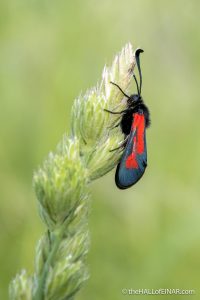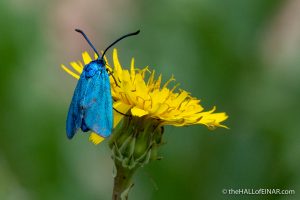The Moth-ers of Invention
I’ve had a moth-er (which is what I think people interested in moths are called) use a moth trap here at Einar before. I’ve even had two moth-ers at once comparing their finds from different moth traps. I’ve just had three moth-ers lighting up their traps over night and it’s been hard to cope with the sheer volume of finds – including three species which are new to the Island.
Here they are, with one of the three different moth traps, with only just enough specimen pots to cope with the specimens which need a closer look to identify them.

A moth trap is a bright light with a box, with varied designs, containing a range of egg crates for the trapped moths to hide under during the early hours of the day:
Here are just a few of our finds:
This is a Garden Tiger moth, Arctia caja, which is always a spectacular find. It has warning colouration, has neurotoxins which are poisonous when eaten, and produces high-pitched squeaks to deter bats. That’s quite some list of adaptations.

This is the Burnished Brass, Diachrysia chrysitis, which has equally fantastic colouring, with golden-brass coloured scales in two bands on the wings. Here it is temporarily on the top of the wall at Einar:

I tried a macro shot of it with my twin-flash and macro lens setup.

I thought it worked quite well until I moved around and tried from a different angle:

Now that’s spectacular.
We also had a number of Beautiful Golden Y moths, Autographa pulchrina, which look particularly amusing from the front with their large plumes:

And they’re also dramatic from the side:

And from the other side, too:

And then, the most spectacular moth of all, a Bedstraw Hawk-moth, Hyles gallii, a species new to Westray, and quite possibly an individual which has flown in from Scandinavia. The reference sites all say: “An immigrant species, normally found at coastal localities“:

In total there were 225 moths in three traps with 30 different species, three of which were new to the Island. That’s a pretty spectacular night’s trapping. Thanks to all three. I very much look forward to doing it all again.
All moths were either not handled at all, or minimally handled, plentiful egg crates were provided for them to shelter in, they were retrieved early, replaced where they were found, and put in safe cover for the day.
More Moths
 Magpie Moths There are Magpie Moths, Abraxas grossulariata, all over the island at the moment. Beautiful, aren't they? The caterpillars feed on… read more
Magpie Moths There are Magpie Moths, Abraxas grossulariata, all over the island at the moment. Beautiful, aren't they? The caterpillars feed on… read more Transparent Burnet Moth There's what looks like a Transparent Burnet moth, Zygaena purpuralis in the park. The larvae feed on wild thyme, which… read more
Transparent Burnet Moth There's what looks like a Transparent Burnet moth, Zygaena purpuralis in the park. The larvae feed on wild thyme, which… read more Forester There's a bright blue iridescent moth flying in the middle of the day in the south of Italy. I have… read more
Forester There's a bright blue iridescent moth flying in the middle of the day in the south of Italy. I have… read more There’s a Dogbane Tiger Moth fluttering around me I'm out in the heat and the noise of a Virginia forest in the summer and I'm suffering. I've bought… read more
There’s a Dogbane Tiger Moth fluttering around me I'm out in the heat and the noise of a Virginia forest in the summer and I'm suffering. I've bought… read more Yellow belts It's the hour that the greyness comes, as the sun sets, shadows lengthen and a fading yellow band retreats below… read more
Yellow belts It's the hour that the greyness comes, as the sun sets, shadows lengthen and a fading yellow band retreats below… read more Bright-line Brown-eye Moth caterpillar There's a green caterpillar on the sand of The Ouse. It's got a bright yellow line along its side and… read more
Bright-line Brown-eye Moth caterpillar There's a green caterpillar on the sand of The Ouse. It's got a bright yellow line along its side and… read more Something hiding on a blade of grass How do you hide on a blade of grass? Simple, make yourself look like a part of the plant. That's… read more
Something hiding on a blade of grass How do you hide on a blade of grass? Simple, make yourself look like a part of the plant. That's… read more Doormoth There's a moth on my doormat. I'm not sure whether it's been wiping all six of its feet or not.… read more
Doormoth There's a moth on my doormat. I'm not sure whether it's been wiping all six of its feet or not.… read more Spots and Burnets and Knapweeds I'm walking in the fields next to the car park at Beachy Head. This really is life on the edge.… read more
Spots and Burnets and Knapweeds I'm walking in the fields next to the car park at Beachy Head. This really is life on the edge.… read more